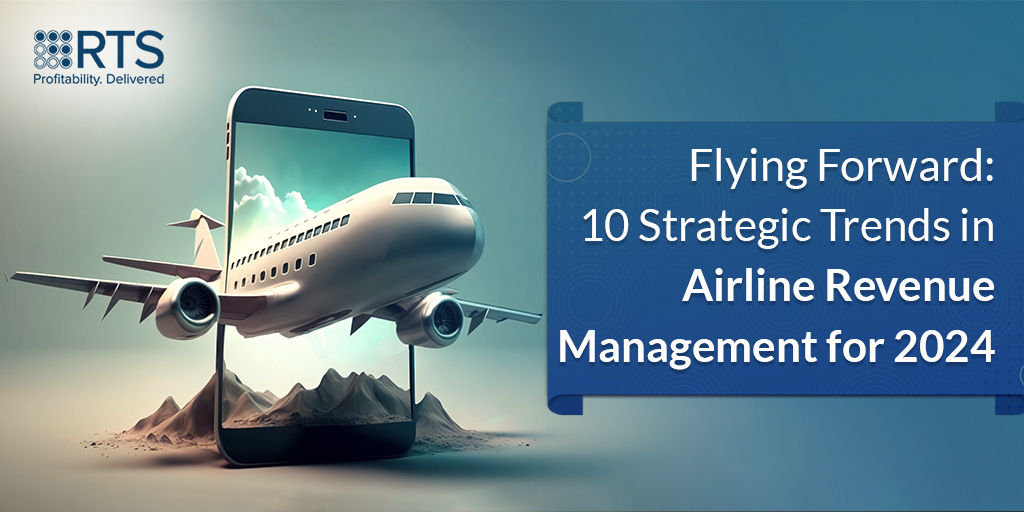The airline industry, a dynamic and ever-evolving sector, is expected to reach a historic high in revenues, touching $964 billion in 2024. The sector is set to experience resurgence in demand, surpassing pre-pandemic levels with an inventory of 40.1 million flights. This optimistic outlook is further supported by the International Air Transport Association (IATA), which anticipates passenger revenues to soar to $717 billion in 2024.
This blog will explore the ten important aspects that will influence airline revenue management in 2024. It will discuss the interplay between advanced technology, market trends, customer preferences, and the new challenges emerging in the post-pandemic era.
(Source: https://www.iata.org/en/pressroom/2023-releases/2023-12-06-01/)
1. Post-Pandemic Revenue Strategies
Airlines are adapting to the post-pandemic environment, where passenger demand is rebounding. This revival will initially outpace supply due to operational bottlenecks such as aircraft re-servicing and crew retraining. It will potentially lead to higher short-term prices. Airlines can look to companies like RTS, with their expertise in revenue management solutions, to overcome these challenges.
2. Technology Trends in Revenue Management
The infusion of technology in airline revenue management is essential. Advanced analytics, AI, and machine learning are reshaping forecasting and pricing strategies. Airlines should prioritize investments in these areas and consider partnerships with tech providers to enhance their revenue management capabilities.
3. Dynamic Pricing Innovations
Airlines are increasingly leveraging real-time data for dynamic pricing, integrating competitive intelligence into their strategies. The adoption of more granular data analytics helps in customizing offers based on individual traveller profiles, thereby optimizing pricing strategies.
4. Sustainability Impact on Revenue
Sustainability is a growing concern among passengers and regulators. Initiatives like the Carbon Offsetting and Reduction Scheme for International Aviation (CORSIA) and increasing customer preference for eco-friendly travel options are compelling airlines to integrate sustainable practices into their revenue management plans. Airlines that align with these green trends are likely to attract a more environmentally conscious customer base.
5. Collaborative Revenue Approaches
Collaboration and alliances are becoming crucial in shaping revenue strategies. Airlines are forming partnerships to enhance operational efficiency, share resources, and broaden market reach. This will positively impact revenue management. For example, code-sharing agreements aid airlines to offer a wider range of destinations without additional costs. Joint ventures in specific routes can lead to shared revenues and cost savings. Such collaborations can lead to better utilization of capacity, shared customer bases, and a stronger presence in competitive markets.
6. Customer-Centric Revenue Strategies
Adopting customer-centric approaches is a key to improving passenger experiences and building loyalty. Airlines are focusing on ancillary revenue strategies, such as offering personalized services and products, to cater to individual passenger needs. This approach can be increased by utilising revenue management systems like those offered by RTS. They can help airlines to understand and respond to customer preferences more effectively.
7. Regulatory Influences on Pricing
Changes in government policies, taxes, and industry regulations are significantly impacting airline pricing and revenue management. Airlines must stay agile and responsive to these regulatory changes to maintain profitability and compliance.
8. Data Security in Revenue Management
With the increased reliance on customer data for personalized pricing strategies, data security and privacy have become vital. Airlines must ensure strong data protection measures to maintain customer trust and comply with evolving privacy regulations.
9. Market Trends and Forecasting
Understanding and adapting to market trends is crucial for successful revenue management. Accurate forecasting based on market analysis helps airlines to anticipate changes in demand and adjust their strategies accordingly. Some of the market trends that influence the airline revenue management include consumer behaviour, air travel demand, technological advancements, geopolitical events, and economic fluctuations. Airlines must leverage analytical tools and maintain a key awareness of the market to navigate these trends successfully.
10. Post-COVID Demand Patterns
Airlines are witnessing a shift in demand patterns post-COVID. The need to adapt revenue management strategies to these new patterns is imperative. Airlines are using data analytics to understand these changes and modify their pricing and capacity planning strategies accordingly.
Bottom Line
As we move into 2024, the airline industry is poised for a transformative phase. By implementing advanced technologies, aligning with sustainability trends, focusing on customer-centric approaches, and adapting to dynamic market conditions, airlines can effectively manage their revenues in this new era. Companies like RTS are at the forefront, offering solutions that can help airlines to adapt these complex changes and capitalize on emerging opportunities.
